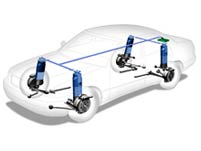Bose independent electromagnetic suspension system
A car that can jump over obstacles
Bose, well known for their audio systems (including noise cancellation), have entered into the automotive world.
Dr. Bose, who started the company many years ago after fixing radios as a kid,became a prof. of electrical engineering at MIT. He is still the private owner of his company. Many argue that he would have been kicked out of the company as CEO by now had it been public. He just has outlandish ideas that take 5-10 years to develop, but they have come through in the past.
Perhaps it makes sense. You see little innovation lately from Ford, GM, Chrysler. Why? Is it the lack of technology available? Nope. It's because those companies are struggling so much that they concentrate only on short term profits. The funny thing is, in the end, it's this strategy that will be the end of the big 3. GM is in the biggest red right now; Ford is trying to drastically change, Chrysler is still slightly profitable. Time will tell who lasts.
Anyhoo, when this system becomes available in a luxary car 5-8 years from now, I'm buying it. Just to ride over those damn huge speed bumps and not feel a thing! MUHAHAHAHAHAAH. ;) Just imagine!
The real neat thing is that it solves the problem of comfort vs control. With conventional passive suspension systems with springs/dampers, a smooth ride and turnability were trade-offs. No more.
A linear electromagnetic motor is installed at each wheel of a Bose equipped vehicle.
The control algorithms operate by observing sensor measurements taken from around the car and sending commands to the motors.
The control algorithms operate by observing sensor measurements taken from around the car and sending commands to the motors.


5 Comments:
What would the energy demand of such a system be?
Well, the design specs of this system are still shrouded in secrecy, however, I can make some comments ;)
Obviously, this is an active, not a passive system. Hence, the fuel efficiency of the car will decrease (since your standard struts/suspension do not directly consume any electrical or mechanical energy). However, I don't think it would be that significant (2-10% maybe.)
It's something we would come to live with; power steering reduces fuel efficiency by perhaps 5%, but everyone still uses that,don't they?
I do think that the instantaneous power demand, as well as the voltage requirement, of these linear induction motors would be too much for existing 12V system capacities. I think this system would probably require 42V. However, the auto industry is headed in that direction. Without 42V, barring any leap in motor technology, Electric power steering systems, electric braking, etc simply cannot be implemented on larger vehicles.
Did that answer your question? ;)
On an unrelated note, did you get my phone message?
Dumbass. ;)
With the Sensor Web course I've been taking, we've seen some examples of in-vehicle sensors being used, and it's pretty cool. We started hypothesizing about where it could be in a good 10 years.
For example, you could combine location-based services (ie, GPS in your car) with other spatial databases, voice recognition, and a heads up display on the windshield and come up with a system where you say "Where is building X?", and the display on your windshield could have an arrow showing you which direction to go. We started thinking too that if you had all the building footprints and heights of an urban area, it could even highlight the building on your windshield.
My guess is that one day we'll look back on things like OnStar as just the beginning. GPS, GIS, and Sensor technology could do some pretty wild stuff.
This message has been brought to you by the MEMF Lab at the University of Windsor. :)
No I did not get any phone message.
Post a Comment
<< Home